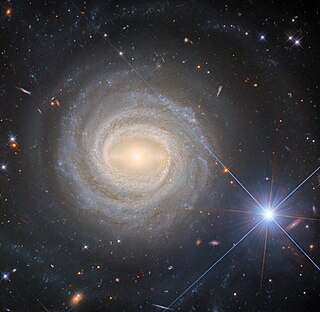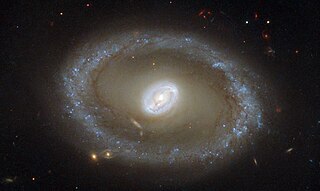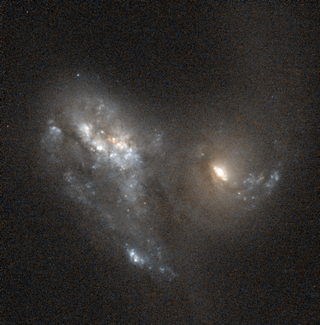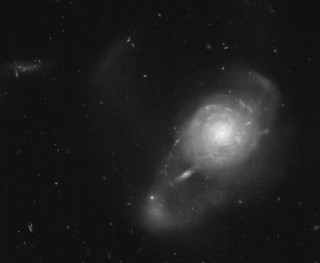An active galactic nucleus (AGN) is a compact region at the center of a galaxy that emits a significant amount of energy across the electromagnetic spectrum, with characteristics indicating that this luminosity is not produced by the stars. Such excess, non-stellar emissions have been observed in the radio, microwave, infrared, optical, ultra-violet, X-ray and gamma ray wavebands. A galaxy hosting an AGN is called an active galaxy. The non-stellar radiation from an AGN is theorized to result from the accretion of matter by a supermassive black hole at the center of its host galaxy.

NGC 3783 is a barred spiral galaxy located about 135 million light years away in the constellation Centaurus. It is inclined by an angle of 23° to the line of sight from the Earth along a position angle of about 163°. The morphological classification of SBa indicates a bar structure across the center (B) and tightly-wound spiral arms (a). Although not shown by this classification, observers note the galaxy has a luminous inner ring surrounding the bar structure. The bright compact nucleus is active and categorized as a Seyfert 1 type. This nucleus is a strong source of X-ray emission and undergoes variations in emission across the electromagnetic spectrum.

NGC 4698 is a barred spiral galaxy located around 55 million light years away from Earth in the constellation of Virgo. It belongs to the Virgo Cluster of galaxies and is positioned near the northeastern edge of this assemblage. The morphological classification of NGC 4698 in the De Vaucouleurs system is SA(s)ab, which indicates a purely spiral structure with moderate to tightly wound arms. It is inclined to the line of sight from the Earth by an angle of 53° along a position angle of 170°.

NGC 3081 is a barred lenticular ring galaxy in the constellation of Hydra. NGC 3081 is located about 85 million light-years away from Earth, which means, given its apparent dimensions, that NGC 3081 is approximately 60,000 light-years across. It is a type II Seyfert galaxy, characterised by its bright nucleus. It was discovered by William Herschel on 21 December 1786.

NGC 7469 is an intermediate spiral galaxy in the constellation of Pegasus. NGC 7469 is located about 200 million light-years away from Earth, which means, given its apparent dimensions, that NGC 7469 is approximately 90,000 light-years across. It was discovered by William Herschel on November 12, 1784.

NGC 7130 is a spiral galaxy located in the constellation Piscis Austrinus. It is located at a distance of about 220 million light years from Earth, which, given its apparent dimensions, means that NGC 7130 is about 100,000 light years across. It was discovered by John Herschel on September 25, 1834, and discovered independently by Lewis Swift on September 17, 1897. The location of the galaxy given in the New General Catalogue was off by 30 arcminutes in declination from the location of the galaxy.

NGC 7674 is a spiral galaxy located in the constellation Pegasus. It is located at a distance of about 350 million light years from Earth, which, given its apparent dimensions, means that NGC 7674 is about 125,000 light years across. It was discovered by John Herschel on August 16, 1830.

NGC 4636 is an elliptical galaxy located in the constellation Virgo. It is a member of the NGC 4753 Group of galaxies, which is a member of the Virgo II Groups, a series of galaxies and galaxy clusters strung out from the southern edge of the Virgo Supercluster. It is located at a distance of about 55 million light years from Earth, which, given its apparent dimensions, means that NGC 4636 is about 105,000 light years across.

NGC 1386 is a spiral galaxy located in the constellation Eridanus. It is located at a distance of circa 53 million light years from Earth, which, given its apparent dimensions, means that NGC 1386 is about 50,000 light years across. It is a Seyfert galaxy, the only one in Fornax Cluster.

NGC 2273 is a barred spiral galaxy located in the constellation Lynx. It is located at a distance of circa 95 million light years from Earth, which, given its apparent dimensions, means that NGC 2273 is about 100,000 light years across. It was discovered by Nils Dunér on September 15, 1867.

NGC 1142 is a distorted spiral galaxy in the constellation of Cetus. It is located about 370 million light years away from Earth, which means, given its apparent dimensions, that NGC 1142 is approximately 170,000 light years across. It is a type 2 Seyfert galaxy. It interacts with the elliptical galaxy NGC 1141.

NGC 7592 is an interacting galaxy system located 300 million light years away in the constellation Aquarius. It was discovered by William Herschel on September 20, 1784. The total infrared luminosity is 1011.33 L☉, and thus it is categorised as a luminous infrared galaxy. One of the galaxies hosts a type 2 Seyfert nucleus.

NGC 7679 is a lenticular galaxy with a peculiar morphology in the constellation Pisces. It is located at a distance of about 200 million light years from Earth, which, given its apparent dimensions, means that NGC 7679 is about 60,000 light years across. It was discovered by Heinrich d'Arrest on September 23, 1864. The total infrared luminosity is 1011.05 L☉, and thus it is categorised as a luminous infrared galaxy. NGC 7679 is both a starburst galaxy and a Seyfert galaxy.

NGC 2617 is a Seyfert galaxy in the equatorial constellation of Hydra. It was discovered on February 12, 1885, by French astronomer Édouard Stephan. In 1888, Danish astronomer J. L. E. Dreyer described it as "extremely faint, very small, 2 very faint stars involved". It is located at an estimated distance of 202 million light years. In the infrared, the galaxy has an angular size of 0.693 by 0.652 arcminutes.

NGC 7172 is a spiral galaxy located in the constellation Piscis Austrinus. It is located at a distance of about 110 million light years from Earth, which, given its apparent dimensions, means that NGC 7172 is about 100,000 light years across. It was discovered by John Herschel on September 23, 1834.

Markarian 590, also known as NGC 863, NGC 866, and NGC 885, is a spiral galaxy located in the constellation Cetus. It is located at a distance of about 300 million light years from Earth, which, given its apparent dimensions, means that NGC 863 is about 110,000 light years across. It is a change looking Seyfert galaxy.

Markarian 273 is a galaxy merger located in the constellation Ursa Major. It is located at a distance of about 500 million light years from Earth, which, given its apparent dimensions, means that Markarian 273 is about 130,000 light years across. It is an ultraluminous infrared galaxy and a Seyfert galaxy.

NGC 2110 is a lenticular galaxy located in the constellation Orion. It is located at a distance of about 120 million light years from Earth, which, given its apparent dimensions, means that NGC 2110 is about 90,000 light years across. It was discovered by William Herschel on October 5, 1785. It is a Seyfert galaxy.

NGC 5135 is a barred spiral galaxy located in the constellation Hydra. It is located at a distance of about 200 million light years from Earth. It was discovered by John Herschel on May 8, 1834. It is a Seyfert galaxy.

NGC 7682 is a barred spiral galaxy in the constellation Pisces. It is located at a distance of about 180 million light years from Earth, which, given its apparent dimensions, means that NGC 7682 is about 65,000 light years across. It was discovered by Heinrich d'Arrest on September 23, 1864.



















